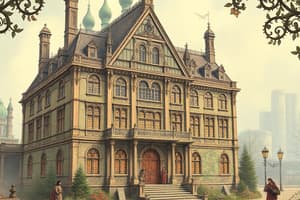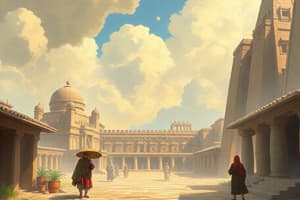Podcast
Questions and Answers
What is a primary aim of studying history?
What is a primary aim of studying history?
- To classify artifacts
- To provide descriptive interpretations of past events (correct)
- To justify current societal norms
- To memorize dates and events
How does history help in understanding the present?
How does history help in understanding the present?
- By shaping future technological advancements
- By revealing the interplay between past and present events (correct)
- By providing a fixed interpretation of events
- By influencing cultural traditions directly
Which of the following types of records defines documents in historical context?
Which of the following types of records defines documents in historical context?
- Manuscripts, letters, and books (correct)
- Public performances and oral narratives
- Modern advertisements and publications
- Digital images and sound recordings
What is the significance of recognizing differences between societies through historical study?
What is the significance of recognizing differences between societies through historical study?
What type of sources consist of artifacts?
What type of sources consist of artifacts?
What does the interpretative aim of history focus on?
What does the interpretative aim of history focus on?
What does the thematic approach to history emphasize?
What does the thematic approach to history emphasize?
How does history contribute to cultural insight?
How does history contribute to cultural insight?
What is considered a primary source?
What is considered a primary source?
Which of the following is an example of a tertiary source?
Which of the following is an example of a tertiary source?
What differentiates secondary sources from primary sources?
What differentiates secondary sources from primary sources?
Which option best identifies a primary source?
Which option best identifies a primary source?
An article analyzing a historical figure's speech is classified as what type of source?
An article analyzing a historical figure's speech is classified as what type of source?
Which of these sources is least likely to reflect personal viewpoints?
Which of these sources is least likely to reflect personal viewpoints?
What type of source would a handbook providing factual information about a topic be classified as?
What type of source would a handbook providing factual information about a topic be classified as?
Which of the following is NOT a characteristic of tertiary sources?
Which of the following is NOT a characteristic of tertiary sources?
What is meant by historical context?
What is meant by historical context?
How does historical context benefit students analyzing primary sources?
How does historical context benefit students analyzing primary sources?
Why might students struggle with applying modern thinking to historical events?
Why might students struggle with applying modern thinking to historical events?
Which of the following is a type of visual source mentioned as powerful?
Which of the following is a type of visual source mentioned as powerful?
What role do architects and builders play concerning historical context?
What role do architects and builders play concerning historical context?
What was the primary goal of Pigafetta's voyage around the world?
What was the primary goal of Pigafetta's voyage around the world?
In the analysis of historical events, what does context offer?
In the analysis of historical events, what does context offer?
Why is it essential to differentiate between causes and context in historical analysis?
Why is it essential to differentiate between causes and context in historical analysis?
Who commissioned Pigafetta to accompany Magellan on his expedition?
Who commissioned Pigafetta to accompany Magellan on his expedition?
In what way can judges use historical context?
In what way can judges use historical context?
Which area was NOT part of Pigafetta's journey?
Which area was NOT part of Pigafetta's journey?
What aspect of society does Pigafetta's account provide valuable insights into?
What aspect of society does Pigafetta's account provide valuable insights into?
Which artistic movement is characterized by the emphasis on emotion and imagination?
Which artistic movement is characterized by the emphasis on emotion and imagination?
What role did competition play in the context of Pigafetta’s voyage?
What role did competition play in the context of Pigafetta’s voyage?
Which of the following best describes the Romantic movement?
Which of the following best describes the Romantic movement?
What was one of the past views of Pigafetta’s account?
What was one of the past views of Pigafetta’s account?
What was the primary influence on Juan Luna's artwork?
What was the primary influence on Juan Luna's artwork?
What significant change is noted in the color scheme of Juan Luna's artwork?
What significant change is noted in the color scheme of Juan Luna's artwork?
How is Juan Luna's depiction of Spain in his artwork interpreted today?
How is Juan Luna's depiction of Spain in his artwork interpreted today?
What was a notable aspect of the relationship between the depicted women in the artwork?
What was a notable aspect of the relationship between the depicted women in the artwork?
Which of the following best describes the evolution of Luna's approach in his artworks?
Which of the following best describes the evolution of Luna's approach in his artworks?
How many versions of "España y Filipinas" are known to exist?
How many versions of "España y Filipinas" are known to exist?
Which event sparked further research into the history of Luna's painting?
Which event sparked further research into the history of Luna's painting?
What does the use of impressionist techniques in Luna's artwork primarily convey?
What does the use of impressionist techniques in Luna's artwork primarily convey?
Flashcards are hidden until you start studying
Study Notes
What is History?
- History is the study of past events, people, and societies to understand their impact on the present.
- History involves a constant dialogue between the present and the past.
- Historians collect facts, create narratives, and interpret them.
- According to E.H. Carr: "The past is intelligible to us only in the light of the present and we can fully understand the present only in the light of the past."
Importance of Studying History
- Understanding the Past: History helps grasp the influence of past events on the present.
- Cultural Insight: Studying history broadens understanding of different cultures, bolstering cross-cultural awareness.
- Appreciating Differences: Examining historical contexts allows recognition and appreciation of differences between societies and time periods.
Primary Sources
- Direct evidence of historical events, written or created during the time period being studied.
- Examples include: letters, manuscripts, diaries, journals, oral histories, newspapers, speeches, interviews, memoirs, government documents, photographs, audio recordings, video recordings, artifacts.
- Provide raw material for interpreting the past.
Secondary Sources
- Interpretive works that analyze and evaluate primary sources.
- Offer personal perspectives while summarizing and evaluating primary material.
- Examples: textbooks, monographs, encyclopedias, analysis articles, review articles, dissertations, theses.
Tertiary Sources
- Compilations and distillations of primary and secondary sources, providing factual representation.
- Offer highly reliable and accurate information with broad perspectives.
- Examples include encyclopedias, directories, dictionaries, handbooks, guides, classifications, chronologies, fact books.
Historical Context and Content
- Historical context refers to the social, religious, economic, and political conditions that existed at a specific time and place.
- Provides the background information that helps interpret and analyze historical events.
- Crucial for understanding the motivations behind historical actions.
- Helps to avoid the pitfalls of judging historical events solely by contemporary standards.
España Y Filipinas Context and Content Analysis
- Juan Luna's "España y Filipinas" is a noteworthy painting from the reform and revolutionary periods.
- Depicts a fair-skinned Hispania guiding a Filipina up a staircase towards the rising sun, representing the Philippines' desire for progress.
- The painting is rooted in Romanticism, an artistic and intellectual movement that emphasized emotion and imagination.
- The use of Impressionist techniques with a shift from dark to bright colors represents Luna's optimistic outlook despite the underlying colonial tensions.
- Luna's "España y Filipinas" reflects the ideal of progress, but also highlights the colonial mindset and the tension between desire and reality.
- Contemporary interpretations often focus on the interplay between aspirations and colonial oppression.
Studying That Suits You
Use AI to generate personalized quizzes and flashcards to suit your learning preferences.




